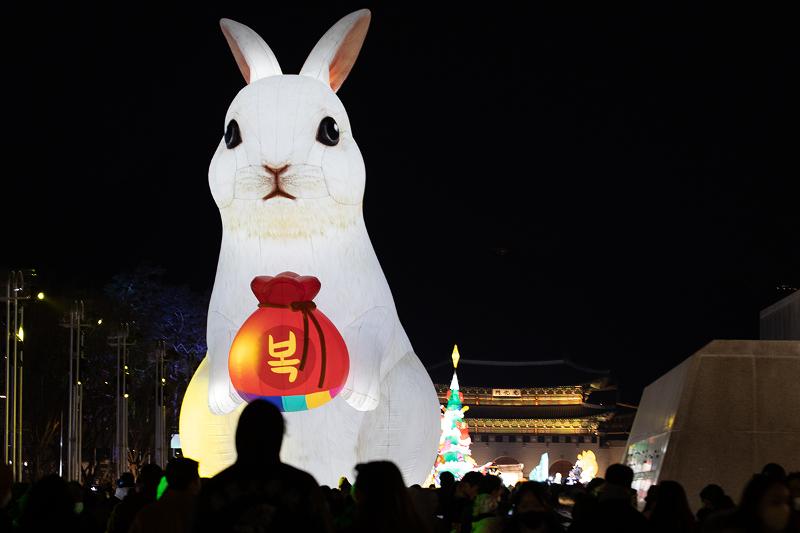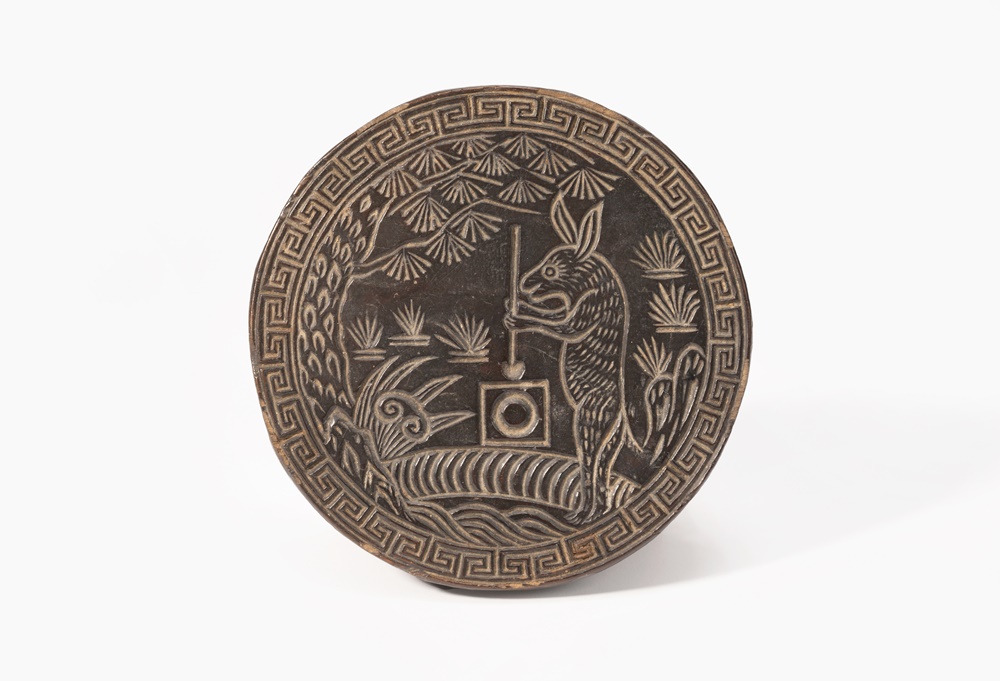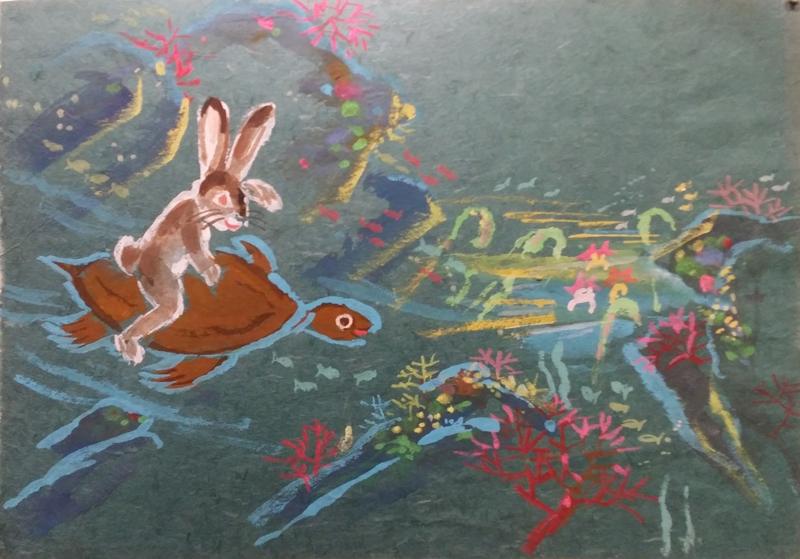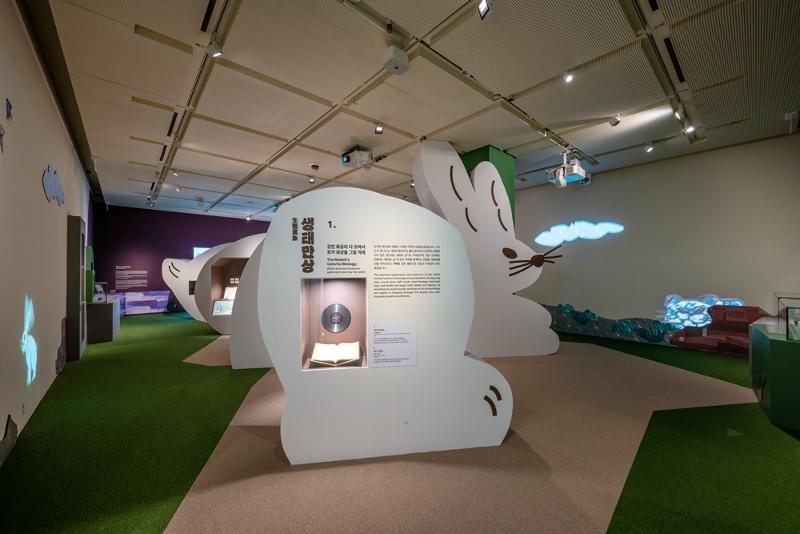
To mark the Year of the Rabbit in 2023, a big rabbit-shaped light installation stands at Gwanghwamun Square in Seoul’s Jongno-gu District. (Kim Sunjoo)
By Lee Jihae
2023 is the Year of the Rabbit under the East Asian zodiac, more specifically Gyemyonyeon (Year of the Black Rabbit) since gye means “black” and myo means “rabbit.”
The rabbit is the fourth of the 12 animals commonly found in the zodiac each with its own direction and auspicious time of the day or week.
The rabbit in Korea has a close connection with the moon. Koreans in ancient times believed that the furry creature lived on the moon as shown in ancient tomb murals of the Goguryeo Kingdom (37 B.C.-A.D. 668), poems in Hanja (Chinese characters), folk paintings and oral literature from the Joseon Dynasty.

In ancient times, Koreans seeing the moon at night believed that a rabbit pounded rice cake there, thus the furry creature symbolized the spirit of the moon, health and longevity. The photo shows an engraving showing a rabbit making rice cake under an imaginary laurel tree. (National Folk Museum of Korea)
In the Korean children’s song “Bandal” (Half Moon), a rabbit makes rice cake using a millstone on the moon. A fable of a rabbit and an imaginary laurel tree on the moon is also found in China and Japan as well as Korea.
In Korean folklore, the rabbit is often featured as a clever character who uses tricks to get out of trouble. For example, the fable “A Rabbit and a Tiger” has a rabbit elude a tiger who tries to eat him.
A rabbit is also a smart character who survives danger by adapting in both “Sugungga” (Song of the Underwater Palace), one of the five pansori (solo lyrical opera) epics, and the Hangeul-written literary work “Byeoljubujeon” (The Hare’s Liver). The rabbit is promised wealth and honor by a turtle if he goes to the underwater palace Yonggung. When the Dragon King tries to cut open the rabbit’s stomach to get his liver for use as medicine, the rabbit lies that he left his organ on land to escape death.

A smart rabbit escapes from danger through tricks by deceiving the turtle and the Dragon King, who wants the rabbit’s liver, in both the pansori (solo lyrical opera) epic “Sugungga” and the Hangeul-written literary work “Byeoljubujeon” (The Hare’s Liver). The painting shows the rabbit heading to the underwater palace Yonggung on the turtle’s back. (National Folk Museum of Korea)
A rabbit’s IQ is known to be 50, higher than that of the tiger (45) or turtle (20). Despite weak eyesight, a rabbit has eyes with a viewing angle wide enough to see all 360 degrees with both facing each side. It is eight times more sensitive to light than a human and can see well in dark areas. It is also twice as sensitive to sounds and can hear things from distant areas. Since they can sense enemies from afar and escape fast, rabbits have symbolized agility since ancient times.
Korea has many places with rabbit-related names. The National Geographic Information Institute said that as of 2011, the names of 158 of 1.54 million venues nationwide were rabbit related.
To mark the Year of the Rabbit, the country has a range of scheduled events.
On the occasion of the Year of the Rabbit, the National Folk Museum of Korea in Seoul’s Jongno-gu District through March 6 will host the exhibition “Here Comes a Rabbit” featuring the symbolism and meaning of the creature in Korean culture. Admission is free.
Seoul Grand Park in Gwacheon, Gyeonggi-do Province, through Feb. 26 will host the outdoor display “2023 Jump Project” featuring 23 rabbit-shaped works of art.
The Corea Cartoon Art Association and Korea Manhwa Contents Agency also through Feb. 26 will host a rabbit-themed cartoon exhibition in collaboration with 60 cartoonists from Korea and Japan at the Korea Manhwa Museum in Bucheon, Gyeonggi-do.
A 15 m-tall installation work shaped like a rabbit is displayed at the Global Fair near the main gate of Everland, one of Korea’s leading theme parks, in Yongin, Gyeonggi-do.

The National Folk Museum of Korea in Seoul through March 6 hosts the exhibition “Here Comes a Rabbit” to mark the Year of Gyemyo (Black Rabbit). (National Folk Museum of Korea)
jihlee08@korea.kr























